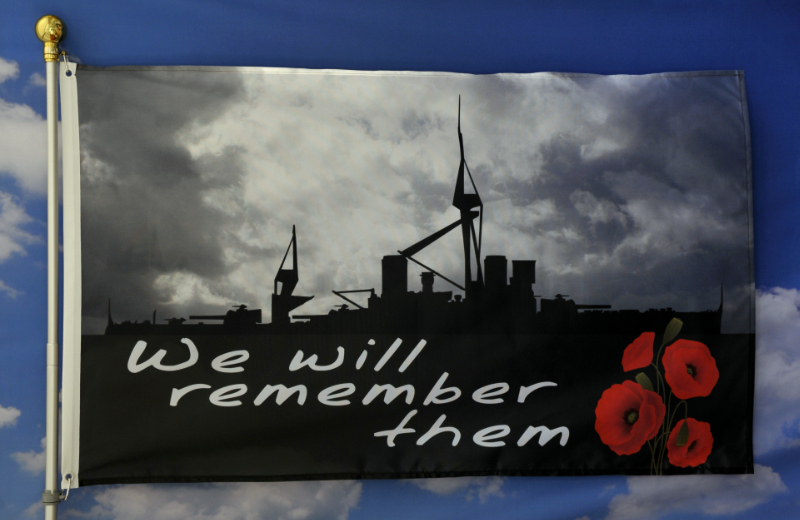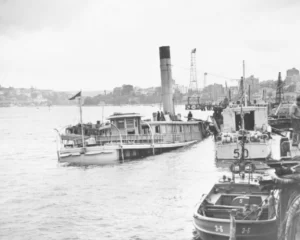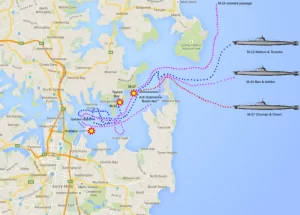
ATTACK ON SYDNEY HARBOUR – 82nd Anniversary
On the night of May 31st and into the early hours of June 1st, 1942, three Imperial Japanese Navy Midget Submarines launched a daring attack on Sydney Harbour. This event, sometimes referred to as the “Battle of Sydney,” marked a significant moment in Australia’s involvement in World War II.
The audacious attack was meticulously planned and preceded by several reconnaissance flights over Sydney, which gathered valuable intelligence. The primary targets within the harbor were the Allied warships, including the HMAS Canberra and the USS Chicago.
The first of the three midget submarines to penetrate Sydney Harbour was M-27, commanded by Lieutenant Kenshi Chuman and Petty Officer Takeshi Omori. Entering around 8 pm, M-27 soon encountered trouble as its propellers became entangled in anti-submarine nets near the western boom gate. The disturbance was quickly noticed and reported, leading to the deployment of patrol boats HMAS Yarroma and HMAS Lolita. However, by the time these patrol boats arrived, the crew of M-27 had detonated demolition charges, destroying their vessel at 10:37 pm.
 The second submarine, M-24, entered the harbor at 9:48 pm, manned by Sub-Lieutenant Katsuhisa Ban and Petty Officer Mamoru Ashibe. Despite being sighted by the USS Chicago, M-24 was not successfully repelled by the defensive gunfire. Approximately half an hour after being spotted, M-24 fired two torpedoes at the Chicago. Both torpedoes missed their intended target; one ran ashore at Garden Island, while the other struck the sea wall near the Sydney Harbour ferry Kuttabul, which was serving as a Royal Australian Navy depot ship. The explosion caused the Kuttabul to sink, resulting in the tragic loss of 21 Allied naval ratings and leaving others injured or trapped. M-24 and its crew managed to exit the harbor, but their fate remained a mystery until 2006 when the wreck was discovered off Sydney’s northern beaches.
The second submarine, M-24, entered the harbor at 9:48 pm, manned by Sub-Lieutenant Katsuhisa Ban and Petty Officer Mamoru Ashibe. Despite being sighted by the USS Chicago, M-24 was not successfully repelled by the defensive gunfire. Approximately half an hour after being spotted, M-24 fired two torpedoes at the Chicago. Both torpedoes missed their intended target; one ran ashore at Garden Island, while the other struck the sea wall near the Sydney Harbour ferry Kuttabul, which was serving as a Royal Australian Navy depot ship. The explosion caused the Kuttabul to sink, resulting in the tragic loss of 21 Allied naval ratings and leaving others injured or trapped. M-24 and its crew managed to exit the harbor, but their fate remained a mystery until 2006 when the wreck was discovered off Sydney’s northern beaches.
The third and final midget submarine, M-22, entered the harbor in the early hours of June 1st. Crewed by Lieutenant Kieu Matsuo and Petty Officer 1st Class Masao Tsuzuku, M-22 was detected in Taylors Bay. The patrol boats launched repeated depth charge attacks, severely crippling the vessel. The following day, the two-man crew was found dead inside M-22, having taken their own lives.
The unexpected and bold attack by the three midget submarines served as a stark wake-up call to many Sydneysiders, who had previously viewed the war as a distant conflict. This incident marked a turning point, reshaping perceptions of Australia’s role in the war and highlighting its strategic importance as a springboard for Allied operations against Japan in the Pacific. The loss of 21 Allied lives, along with the deaths of the four Japanese submariners, underscored the harsh realities of war.
The 19 Australians and 2 British ratings who perished were honoured with a burial service with full naval honours. The four Japanese submariners were also accorded a funeral with naval honours at Rookwood Cemetery, a gesture that was appreciated by Japan in the years that followed. Two months later, their cremated remains were repatriated to Japan in a diplomatic exchange.
The remnants of the two recovered midget submarines were combined to create a composite vessel, now displayed at the Australian War Memorial in Canberra. This exhibit, which includes the wheelhouse from the Kuttabul, serves as a poignant reminder of the events of that night.
This year marks the 82nd anniversary of the attack on Sydney Harbour. As we reflect on this historical moment, we honour and remember those who defended Australia on the night of May 31st and into June 1st, 1942, recognizing their bravery and the profound impact of World War II on our nation.
Photo: Ferry Kuttabul lying on the seabed following M-24’s torpedo attack. Source: www.navy.gov.au





Japanese over Melbourne in WWII.
On 17 February 1942, a Japanese “mother submarine” – I-25 (98 crew, 108 metres in length – three times the displacement of a German U-boat), launched a “collapsible” Yokosuka E14Y “Glen” float-plane that overflew parts of Sydney – causing consternation in harbour-side suburbs. The unarmed Glen reconnaissance float-plane had a crew of two, and could be dismantled – broken-down into twelve pieces, and stored on the submarine in four water-tight “hangar”compartments forward of the submarine’s conning tower. Once assembled, it was launched from rails by a catapult.
From the Sydney area, the I-25 submarine sailed south into Bass Strait and anchored off Cape Wickham (King Island). On 26 February 1942, the Glen aircraft was launched and overflew Point Lonsdale, Geelong, Laverton and Melbourne. Anti-aircraft gunners at Williamstown spotted the Glen and were ready to fire, but the officer-in-charge delayed while he sought permission – and “the moment was lost.” The Glen aircraft flew along the Yarra at an altitude of 300 metres, past Port Melbourne and South Melbourne, and then down to St Kilda, Brighton, and Sandringham. RAAF Wirraway aircraft were reportedly “scambled” from Laverton, but lost the Glen in the cloud-cover. The Glen returned to its I-25 mother-ship off Cape Wickham after its successful three-hour flight. The Glen aircraft later did flights from the I-25 over Hobart, Auckland, Wellington and Suva – before returning to its base at Kwajalein in the Marianas/Marshal Islands, and later dropped a small number of incendiary bombs into the forests of Oregon (US).
The I-25 was sunk by US destroyers near Espiroto Santo (Vanuatu) in October 1943.